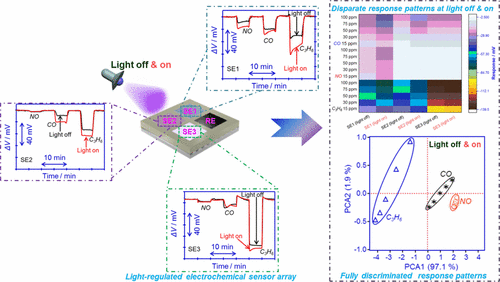Our official English website, www.x-mol.net, welcomes your feedback! (Note: you will need to create a separate account there.)
Light-Regulated Electrochemical Sensor Array for Efficiently Discriminating Hazardous Gases
ACS Sensors ( IF 8.9 ) Pub Date : 2017-09-20 00:00:00 , DOI: 10.1021/acssensors.7b00423 Hongqiu Liang 1 , Xin Zhang 1 , Huihui Sun 2 , Han Jin 1 , Xiaowei Zhang , Qinghui Jin 3 , Jie Zou 1 , Hossam Haick 1 , Jiawen Jian 1
ACS Sensors ( IF 8.9 ) Pub Date : 2017-09-20 00:00:00 , DOI: 10.1021/acssensors.7b00423 Hongqiu Liang 1 , Xin Zhang 1 , Huihui Sun 2 , Han Jin 1 , Xiaowei Zhang , Qinghui Jin 3 , Jie Zou 1 , Hossam Haick 1 , Jiawen Jian 1
Affiliation

|
Inadequate detection limit and unsatisfactory discrimination features remain the challenging issues for the widely applied electrochemical gas sensors. Quite recently, we confirmed that light-regulated electrochemical reaction significantly enhanced the electrocatalytic activity, and thereby can potentially extend the detection limit to the parts per billion (ppb) level. Nevertheless, impact of the light-regulated electrochemical reaction on response selectivity has been discussed less. Herein, we systematically report on the effect of illumination on discrimination features via design and fabrication of a light-regulated electrochemical sensor array. Upon illumination (light on), response signal to the examined gases (C3H6, NO, and CO) is selectively enhanced, resulting in the sensor array demonstrating disparate response patterns when compared with that of the sensor array operated at light off. Through processing all the response patterns derived from both light on and light off with a pattern recognition algorithm, a satisfactory discrimination feature is observed. In contrast, apparent mutual interference between NO and CO is found when the sensor array is solely operated without illumination. The impact mechanism of the illumination is studied and it is deduced that the effect of the illumination on the discriminating features can be mainly attributed to the competition of electrocatalytic activity and gas-phase reactivity. If the enhanced electrocatalytic activity (to specific gas) dominates the whole sensing progress, enhancements in the corresponding response signal would be observed upon illumination. Otherwise, illumination gives a negligible impact. Hence, the response signal to part of the examined gases is selectively enhanced by illumination. Conclusively, light-regulated electrochemical reaction would provide an efficient approach to designing future smart sensing devices.
中文翻译:

高效区分有害气体的光控电化学传感器阵列
对于广泛应用的电化学气体传感器而言,检测限不足和辨别特征不令人满意仍然是具有挑战性的问题。最近,我们证实光调节的电化学反应显着增强了电催化活性,从而有可能将检测极限扩展到十亿分之一(ppb)的水平。然而,光调节电化学反应对响应选择性的影响已很少讨论。在这里,我们通过光调节电化学传感器阵列的设计和制造,系统地报告了照明对识别特征的影响。照明(点亮)时,对所检查气体的响应信号(C 3 H 6,NO和CO)被选择性增强,导致传感器阵列与在熄灯状态下工作的传感器阵列相比,显示出截然不同的响应模式。通过使用模式识别算法处理从开灯和关灯获得的所有响应模式,可以观察到令人满意的判别特征。相反,当传感器阵列仅在没有照明的情况下运行时,会发现NO和CO之间存在明显的相互干扰。研究了照明的影响机理,推论照明对识别特征的影响主要归因于电催化活性和气相反应性的竞争。如果增强的(对特定气体的)电催化活性在整个传感过程中占主导地位,照明后将观察到相应响应信号的增强。否则,照明的影响可忽略不计。因此,通过照明选择性地增强了对一部分被检查气体的响应信号。总之,光调节电化学反应将为设计未来的智能传感设备提供一种有效的方法。
更新日期:2017-09-20
中文翻译:

高效区分有害气体的光控电化学传感器阵列
对于广泛应用的电化学气体传感器而言,检测限不足和辨别特征不令人满意仍然是具有挑战性的问题。最近,我们证实光调节的电化学反应显着增强了电催化活性,从而有可能将检测极限扩展到十亿分之一(ppb)的水平。然而,光调节电化学反应对响应选择性的影响已很少讨论。在这里,我们通过光调节电化学传感器阵列的设计和制造,系统地报告了照明对识别特征的影响。照明(点亮)时,对所检查气体的响应信号(C 3 H 6,NO和CO)被选择性增强,导致传感器阵列与在熄灯状态下工作的传感器阵列相比,显示出截然不同的响应模式。通过使用模式识别算法处理从开灯和关灯获得的所有响应模式,可以观察到令人满意的判别特征。相反,当传感器阵列仅在没有照明的情况下运行时,会发现NO和CO之间存在明显的相互干扰。研究了照明的影响机理,推论照明对识别特征的影响主要归因于电催化活性和气相反应性的竞争。如果增强的(对特定气体的)电催化活性在整个传感过程中占主导地位,照明后将观察到相应响应信号的增强。否则,照明的影响可忽略不计。因此,通过照明选择性地增强了对一部分被检查气体的响应信号。总之,光调节电化学反应将为设计未来的智能传感设备提供一种有效的方法。



























 京公网安备 11010802027423号
京公网安备 11010802027423号